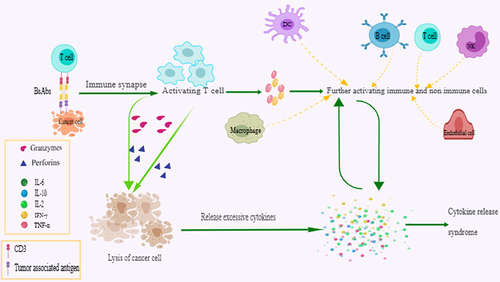Figures & data
Table 1 Summary of published data of cytokine release syndrome (CRS), nephrotoxicity and other risks of nephrotoxicity in the clinical trials of bispecific antibodies (BsAbs) approved for use or not
Figure 1 Reaction mechanism of anti-cancer T-cell engaging bispecific antibodies (BsAbs) after simultaneously link the tumor-associated antigen and CD3, bispecific antibodies (BsAbs) recruit immune cells such as T-cells close to the tumor and lead to the formation of an immune synapse. Formed synapses further induce activation and release of perforins and granzymes by activating immune activity of T-cells and finally result in T-cell-dependent cytotoxic lysis of the cancer cell. The products of cancer lysis also trigger the release of cytokines. Activated T-cells release interferon (IFN)-γ and tumor necrosis factor (TNF)-α, which further promotes the maturation of other immune cells including dendritic cells (DC), macrophages, nature kill (NK) cells, and endothelial cells. Mature immune cells release large amounts of cytokines, and these cytokines in turn activate T-cells and other immune cells.

Figure 2 Proposed major mechanisms of nephrotoxicity in bispecific antibodies (BsAbs) recipients. 1) Cytokine release syndrome with excessive cytokines will function on blood vessels and cause cytokine-driven capillary leak syndrome as well as intravascular volume depletion, which can lead to hypotension and induce prerenal acute kidney injury (AKI) or transient creatinine increased. 2) Excessive cytokines will infiltrate, attack glomerulus tissue, destroy the filtration barrier, and finally induce proteinuria. 3) Too much or too fast lysis of cancer cells will produce excessive calcium salts, phosphate, and uric acid. The accumulation of uric acid, calcium, and phosphate cause the formation of crystals in the kidney tubules, blocking the kidney tubules, inducing infection, and finally leading to tubules necrosis. 4) Under the infection situation, sepsis may be a risk factor of glomerulonephritis.

Table 2 Comparison of severity, cause, main symptoms, and treatment measure of cytokine release syndrome (CRS) associated with T-cell-engaging bispecific antibodies (BsAbs) and chimeric antigen receptor T-cells (CAR-T)
Table 3 Management measures of different mechanism about nephrotoxicity in bispecific antibodies (BsAbs) recipients.
